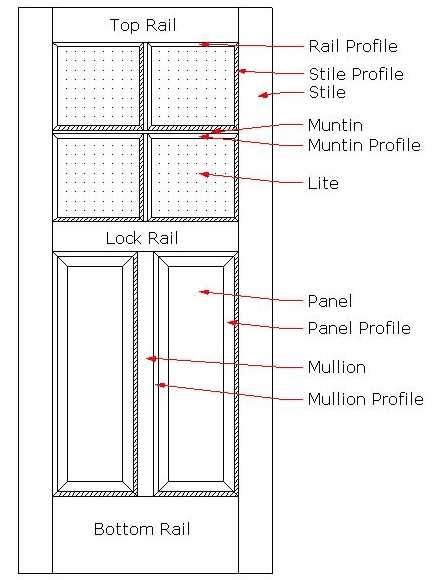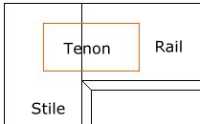Frame and Panel Doors
Frame and panel construction allows a solid wood door to remain true, even as humidity and temperature change.

The basic Frame and Panel layout uses two vertical Stiles, and two horizontal Rails as the frame.The frame is grooved to accept a shaped Solid Wood Panel. The panel is free to expand and contract within the frame. The overall frame size changes very little, so the door opens and closes easily whether the air is dry or moist.
Larger panels are usually divided using Mullions and Mid Rails.
Lites are divided using Muntins
Frame
The strength and stability of kiln dried Douglas Fir is unmatched for use as stile and rail
components.
 The stiles and rails often have a profile cut into the inside edge - usually a
smaller version matching the profile of the panel.
The stiles and rails often have a profile cut into the inside edge - usually a
smaller version matching the profile of the panel.
Cope and stick joinery is achieved with a set of special router cutters.
 These cut the profile
on the edge of the frame parts and also cut a reverse version of the same profile in the ends of
the rail so that they may be fitted to the stiles and glued in place. A floating tenon is glued
into a precut mortise in the end of the rail and the edge of the stile, to reinforce the join.
These cut the profile
on the edge of the frame parts and also cut a reverse version of the same profile in the ends of
the rail so that they may be fitted to the stiles and glued in place. A floating tenon is glued
into a precut mortise in the end of the rail and the edge of the stile, to reinforce the join.
Panels
The panels are captured in a groove made in the inside edge of the frame members.
 Panels are made slightly smaller than the available space within
the frame to provide room for expansion. A typical panel is cut to allow 1/8" clearance between
itself and the frame. An elastic caulking material is placed
in the groove between the edge of the panel and the frame before assembly to seal the door
against air leakage.
Panels are made slightly smaller than the available space within
the frame to provide room for expansion. A typical panel is cut to allow 1/8" clearance between
itself and the frame. An elastic caulking material is placed
in the groove between the edge of the panel and the frame before assembly to seal the door
against air leakage.

The panels may be Flat, Raised Profile, or Beveled Tongue and Groove.
A flat panel has it's visible face flush with the front of the groove in the frame. This gives the panel an inset appearance.
A raised panel is made from thicker stock and has a profile cut into it's edge so that the panel surface is raised above the groove.
